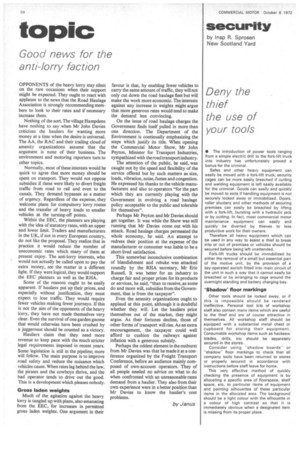security
Page 56

If you've noticed an error in this article please click here to report it so we can fix it.
by Insp R. Sprosen New Scotland Yard
Deny the thief the use of your tools
• The introduction of power tools ranging from a simple electric drill to the fork-lift truck into industry has unfortunately proved a bonus for the criminal.
Safes and other heavy equipment can easily be moved with a fork-lift truck; security cages can be more easily breached if cutting and welding equipment is left easily available for the criminal. Goods can easily and quickly be moved to exits if handling equipment is not securely locked away or immobilized. Doors, roller shutters and other methods of securing premises can easily be breached by lifting with a fork-lift, bursting with a hydraulic jack or by cutting. In fact, most commercial motor maintenance equipment can easily and quickly be diverted by thieves to less productive work for their owners.
Therefore all heavy equipment which can be used in any way to assist a thief to break into or out of premises or vehicles should be secured before being left unattended.
Fork-lift trucks should be immobilized by either the removal of a small but essential part of the motive unit, by the provision of a key-operated switch fitted into main circuit of the unit in such a way that it cannot easily be breached or by arranging to cage around the overnight standing and battery charging bay.
'Shadow' floor markings
Other tools should be locked away, or if this is impossible should be rendered ineffective. Personal tool kits of workshop staff also contain many items which are useful to the thief and are of course attractive in themselves. All workshop staff should be equipped with a substantial metal chest or cupboard for storing their equipment.. Consumable workshop items such as hacksaw blades, drills, etc should be separately secured in the stores.
Consider using "shadow boards" or "shadow" floor markings to check that all company tools have been returned to stores or properly secured in accordance with instructions before staff leave for home.
This very effective method of quickly checking the presence of equipment is by allocating a specific area of floorspace, shelf space, etc, to particular items of equipment and painting silhouettes of these particular items in the allocated area. The background should be a light colour with the silhouette in a colour of high contrast so that it is immediately obvious when a designated item is missing from its proper place.






































































































